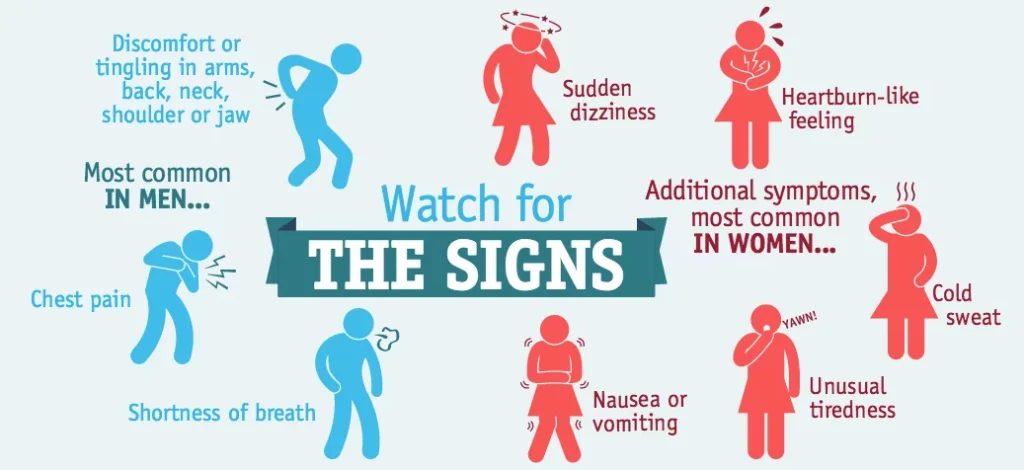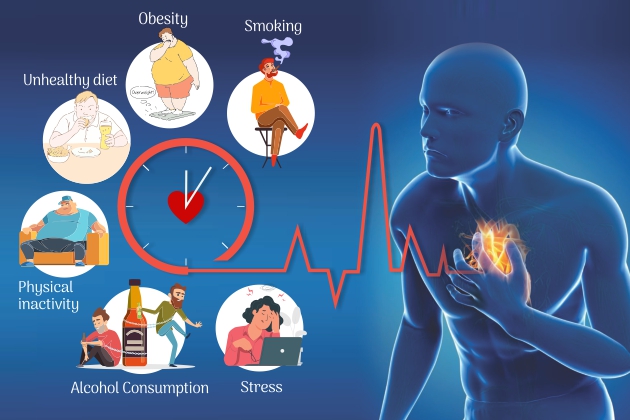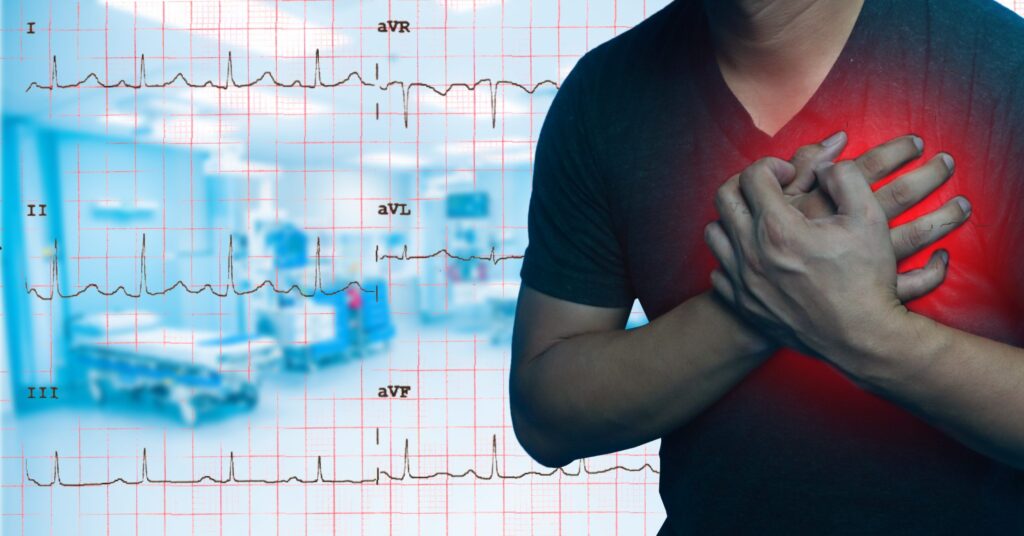
Heart disease includes multiple conditions affecting the heart’s arteries, muscles, rhythm, or valves, such as coronary artery disease, arrhythmia, heart failure, and valve disorders. Symptoms vary from chest pain and fatigue to hidden signs like nausea and swelling, demanding timely recognition and diagnosis for effective prevention and treatment.
Key Takeaways
- Major types: coronary artery disease, arrhythmia, heart failure, valvular defects.
- Early symptoms: chest pain, shortness of breath, palpitations, unexplained fatigue.
- Hidden signs: nausea, dizziness, swelling, pale skin, poor exercise tolerance.
- High-risk groups: older adults, diabetics, and those with family history or obesity.
- Diagnosis: ECG, stress test, echocardiogram, angiogram, and blood tests.
- Emergency signs: severe chest pain, sudden breathlessness, fainting, irregular heartbeat.
- Prevention: balanced diet, regular exercise, quitting smoking, and routine checkups.
Understanding Heart Disease
Understanding heart disease requires recognizing it as a group of conditions that impact how the heart functions and its overall structure. These diseases may affect the heart’s arteries, rhythm, muscle strength, or valves.
- Coronary artery disease: Narrowing or blockage of the arteries that supply blood to the heart, reducing oxygen delivery and risking heart attacks.
- Arrhythmias: Abnormal heart rhythms that can cause the heart to beat too fast, too slow, or irregularly, affecting its pumping efficiency.
- Heart failure: A condition where the heart muscle weakens and cannot pump blood effectively to meet the body’s needs.
- Valvular diseases: Problems with the heart valves that can cause blood flow disruptions and increase heart strain.
Heart disease often develops gradually and silently over years, without clear symptoms until it becomes severe. This makes regular screenings important, especially for those with higher risks, including family history, obesity, high blood pressure, and diabetes. Early detection and management are critical to reduce complications and improve outcomes.
Classic Warning Signs of Heart Disease
Certain symptoms are commonly linked to heart problems and should never be ignored. These include:
- Chest pain or discomfort: Often described as pressure, squeezing, fullness, or pain, typically in the center or left side, lasting a few minutes or recurring.
- Pain spreading beyond the chest: Discomfort may radiate to the arms, jaw, neck, back, or stomach.
- Shortness of breath: Difficulty breathing or feeling winded with minimal exertion or even at rest.
- Palpitations: Noticeably irregular, fast, or pounding heartbeats.
- Fatigue: Feeling unusually tired or weak, especially during physical activity.
Hidden or Atypical Symptoms
Heart disease does not always present with the classic chest pain or obvious signs. In many cases, especially in women, older adults, and people with diabetes, the symptoms can be subtle and easily mistaken for less serious conditions. Recognizing these hidden or atypical symptoms is critical for early detection and treatment.
- Nausea or indigestion: Unexplained stomach discomfort that feels like heartburn or acid reflux, but does not improve with typical antacids, may indicate heart issues. This symptom is often mistaken for a digestive problem instead of a heart-related warning.
- Dizziness or lightheadedness: Feeling faint, dizzy, or unsteady without an obvious cause may be a sign of irregular heart rhythm or reduced blood flow to the brain due to heart disease.
- Excessive sweating: Sudden cold sweats, especially when not linked to physical activity or heat, can signal an acute cardiac event. This symptom often goes unnoticed or attributed to anxiety or nervousness.
- Pale or clammy skin and a sense of anxiety or impending doom: These subtle signs, including a feeling of nervousness or fear for no apparent reason, often accompany heart-related problems and can be early indicators of an impending heart attack or serious cardiac event.
Silent Symptoms: What Gets Missed
Heart disease sometimes presents with subtle signs that are easy to dismiss. Monitor for these silent symptoms:
- Unexplained fatigue after mild activity: Feeling drained despite adequate rest.
- Swelling in legs, feet, or ankles: Fluid buildup indicating possible heart failure.
- Sleep problems such as waking up breathless or needing extra pillows to breathe comfortably.
- Chest fluttering or rapid heartbeat: Sensations of irregular heart rhythm.
- Poor exercise tolerance: Getting out of breath quickly or unable to keep up with usual activities.
Symptoms by Type of Heart Disease

Symptoms vary depending on the specific heart disease, and recognizing these differences helps with early detection and treatment.
Coronary Artery Disease
Coronary artery disease occurs when the arteries supplying blood to the heart muscle become narrowed or blocked, reducing the flow of oxygen-rich blood and increasing the risk of chest pain, heart attacks, and other serious complications.
- Chest pain or discomfort, often described as pressure or squeezing
- Shortness of breath, especially during physical activity
- Pain radiating to the arms, neck, jaw, or back
Arrhythmias
Arrhythmias are irregular heart rhythms that disrupt the normal pattern of heartbeats, causing the heart to beat too fast, too slow, or unevenly. This can affect blood flow and result in symptoms such as palpitations, dizziness, or fainting.
- Palpitations or feeling the heart racing or skipping beats
- Dizziness or lightheadedness
- Fainting or near-fainting episodes
Heart Failure

Heart failure is a condition in which the heart muscle weakens and cannot pump enough blood to meet the body’s needs, leading to symptoms like swelling, breathlessness, and fatigue. This ongoing problem affects daily life and requires careful management.
- Swelling in the legs, ankles, or abdomen (edema)
- Sudden weight gain due to fluid retention
- Persistent shortness of breath, especially when lying down or during exertion
Congenital Heart Defects
Congenital heart defects are structural problems in the heart present from birth. These conditions can affect how blood flows through the heart and often cause symptoms such as bluish skin, poor growth, or difficulty breathing in infants and children.
- Bluish tint to the skin or lips (cyanosis) in infants or children
- Poor growth or difficulty feeding in infants
- Rapid breathing or fatigue during activity
Valvular Disease
Valvular disease involves malfunction of one or more of the heart’s valves, which can disrupt normal blood flow inside the heart and lead to symptoms such as heart murmurs, palpitations, and fatigue.
- Detectable heart murmurs during a medical exam
- Palpitations or irregular heartbeat
- Fatigue and reduced exercise tolerance
Risk Factors Influencing Warning Signs
Risk factors often determine the likelihood of heart disease and how symptoms present. These include:
- Age and gender: Risk increases with age; men and postmenopausal women are more vulnerable.
- Family history: Genetic predisposition plays a significant role.
- Lifestyle: Smoking, unhealthy diet, sedentary habits raise risk.
- Health conditions: Diabetes, high blood pressure, and obesity contribute heavily.
- Genetic factors: Some inherited conditions escalate heart disease chances.
Misinterpreted Symptoms and Delayed Diagnosis
Heart disease symptoms are frequently confused with other conditions, delaying diagnosis. Common misinterpretations include:
- Mistaking chest pain for indigestion or muscle strain.
- Attributing dizziness or fatigue to aging or stress.
- Overlooking mild swelling as minor or unrelated.
When to Seek Emergency Help
Knowing when to act quickly on heart symptoms is vital. Immediate medical attention can prevent severe damage or death. You should seek emergency help without delay if you experience any of the following:
- Severe and persistent chest pain lasting more than a few minutes: This could indicate a heart attack or acute coronary syndrome and should never be ignored.
- Sudden shortness of breath or difficulty breathing: If you find it hard to breathe or feel like you are choking, it might be a sign of heart failure or a serious cardiac event.
- Loss of consciousness or fainting: Fainting or passing out can result from dangerous heart rhythm disturbances or insufficient blood flow.
- Rapid or irregular heartbeat accompanied by dizziness or weakness: These symptoms can signal arrhythmias that may require urgent treatment.
- Sudden swelling of the face, lips, or throat: This could indicate an allergic reaction affecting breathing or heart-related fluid retention issues requiring immediate care.
Diagnostic Approach: What Happens Next
Once symptoms suggest possible heart disease, healthcare providers follow a systematic diagnostic approach:
- Electrocardiogram (ECG): This test records the heart’s electrical activity to detect abnormalities in rhythm and identify signs of heart muscle damage.
- Stress tests: These evaluate how the heart performs during physical exertion and help detect reduced blood flow to the heart.
- Imaging: Techniques such as echocardiograms use ultrasound to visualize heart structures and function, while angiograms involve X-rays of coronary arteries to spot blockages.
- Blood tests: Specific markers in the blood can show evidence of heart damage or risk factors like high cholesterol and inflammation.
Preventive Strategies and Monitoring
Prevention and ongoing monitoring play essential roles in heart health. These practical strategies help reduce risk and ensure early detection of problems:
- Maintain a heart-healthy diet: Focus on eating plenty of fruits, vegetables, whole grains, and lean proteins while limiting salt, saturated fats, and processed foods.
- Engage in regular physical activity: Exercise supports cardiovascular fitness but should be adapted to individual health status and recommendations.
- Control blood pressure, blood sugar, and cholesterol: Keeping these key health factors in check with medication and lifestyle changes reduces heart strain and disease progression.
- Avoid smoking and limit alcohol consumption: Both habits damage the heart and increase the risk of complications.
- Monitor symptoms routinely and attend regular checkups: Keeping track of any new or worsening symptoms and having periodic medical exams helps catch issues early when they are most treatable.
Conclusion
Heart disease symptoms can be classic or subtle, with some signs easy to dismiss. Recognizing early warning signs whether typical chest pain or hidden symptoms like nausea is vital for timely care. Risk factors such as age, lifestyle, and other conditions influence presentation and severity.
Misdiagnosis can delay treatment and worsen outcomes. Urgent emergency care is necessary for severe chest pain, breathing difficulties, or fainting. Accurate diagnosis requires tests that reveal heart function and damage. Preventive strategies, including a healthy lifestyle and regular monitoring, help protect heart health and improve long-term outcomes.
FAQs
What are the earliest symptoms of heart disease most people ignore?
Fatigue, mild chest discomfort, and breathlessness often go unnoticed.
How can women’s heart disease symptoms differ from men’s?
Women may have atypical symptoms like nausea, dizziness, and jaw pain rather than classic chest pain.
Does heart disease always present as chest pain?
No, many patients experience other symptoms such as shortness of breath or fatigue.
Can fatigue and sleep problems be heart disease warning signs?
Yes, unexplained tiredness and disrupted sleep can indicate heart failure or arrhythmia.
Which symptoms are considered medical emergencies?
Severe chest pain, sudden breathlessness, fainting, or rapid irregular heartbeat require urgent care.
How is heart disease diagnosed after initial symptoms appear?
Through ECG, stress tests, imaging, and blood tests to confirm heart function and damage.
Are there differences in symptoms due to age or other health conditions?
Older adults and people with diabetes may experience less typical symptoms, making diagnosis challenging.
What symptoms in children may point to heart disease?
Poor growth, cyanosis (skin turning blue), and breathing difficulty signal congenital heart issues.
Can digestive issues signal heart problems?
Yes, nausea, indigestion, and heartburn-like symptoms can be early signs in some cases.
Which lifestyle changes help in preventing silent heart disease symptoms?
Healthy eating, regular exercise, quitting smoking, and controlling weight are vital preventive steps.
Reference
- Mayo Clinic – Heart disease: Symptoms and causes
https://www.mayoclinic.org/diseases-conditions/heart-disease/symptoms-causes/syc-20353118 - Jackson Health System – 10 heart symptoms you should never ignore
https://jacksonhealth.org/10-heart-symptoms-you-should-never-ignore/ - Hindustan Times – Cardiologist explains 10 signs of heart disease you ignore but shouldn’t
https://www.hindustantimes.com/lifestyle/health/cardiologist-explains-10-signs-of-heart-disease-symptoms-heart-attack-irregular-heartbeat-swollen-feet-jaw-pain-snoring-101755227190313.html - Mount Sinai – Warning signs and symptoms of heart disease
https://www.mountsinai.org/health-library/selfcare-instructions/warning-signs-and-symptoms-of-heart-disease - WHO – Cardiovascular diseases fact sheet
https://www.who.int/news-room/fact-sheets/detail/cardiovascular-diseases-(cvds) - Medical News Today – Early signs of heart disease: Symptoms explained
https://www.medicalnewstoday.com/articles/early-signs-of-heart-disease
Philip Vitale holds an MS in Exercise Physiology from the University of Florida (2015) and is a CSCS (NSCA) with 10 years coaching athletes from amateurs to pros. He focuses on performance nutrition, recovery, and safe ergogenic aids. Philip has supported athletes through EXOS and collegiate programs and delivered workshops on supplement quality and anti-doping. Verify certifications via the NSCA directory; see client outcomes and talks.

